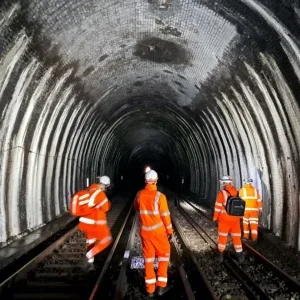Some 20 years ago the term trenchless technology was born as a new shorthand to describe innovative techniques for pipe and small tunnel installation which offered minimum disruption above ground.
Such alternatives to the open cut system, almost always used previously, were becoming vital if the demand for increasing networks of underground services were not to clash with the needs of the travelling public on the surface.
Ted Flaxman, then president of the UK Institution of Public Health Engineers (IPHE), took up the battle to convince his members that they were facing serious infrastructure problems. In urban areas, in particular, new methods were crucial to replace utilities, many of which had been constructed in the late 1800s.
A working party was formed by IPHE which readily appreciated that the UK was not alone in facing problems of ageing utility networks. A first major conference, convened under the title No-Dig ’85 in a former department store in London, attracted a strong body of delegates from overseas.
At its conclusion it was clear that there was a need for the formation of an international organisation to carry the idea forward and International Society for Trenchless Technology (ISTT) was formed.
The new body has encouraged the formation of national and regional societies with similar aims to be affiliated to the international body. The first was the Netherlands Society for Trenchless Technology (NSTT) which was affiliated in 1988. ISTT now has 26 affiliated societies with 4,000 members of the trenchless family in five continents.
Even in those early days, the term No Dig was something of a misnomer, because some digging was invariably necessary for initial access at ground level. To delineate the boundaries of the new technology and to distinguish it from that covered by the well established tunnelling fraternity, the emphasis was placed on pipelines of smaller than man-entry size.
More recently, trenchless techniques have been developed with application well above and below this arbitrary size of pipeline. The distinction now relates more to the use of the pipeline – for utility services – as distinct from transport tunnels.
The early band of trenchless technologists soon found that their solutions were in demand, not simply in urban but also in rural areas where ‘green’ and environmental concerns could make open cut methods unacceptable.
The emerging technology also provided a home for innovative installation techniques. The Americans turned their vertical drilling skills to horizontal applications and HDD developed rapidly, with greatly improved accuracy.
Japanese and German engineers with a flair for miniaturisation and microtunnelling quickly extended the limits of installations in terms of diameter, length of drive, curvature and materials. Chemists joined the party with new plastics and coatings which found applications in rehabilitation of the ageing networks.
Now into the new century, trenchless technology is a vibrant engineering specialisation. It is well established in the more economically developed regions of the world and is increasingly sought in developing countries where population growth has far outgrown the infrastructure to support it.
The ISTT and its affiliates now accept members concerned with all aspects of systems and processes for the installation, replacement or rehabilitation of underground utility services, with minimum surface excavation. They are particularly concerned with the avoidance of environmental damage and the social costs, often associated with open cut methods.
ISTT’s first objective is to advance the science and practice of trenchless technology for the public benefit. This has three aspects. First, even in the most literate engineering communities there are still the sceptics. A frequent charge made is that trenchless methods present a greater risk and are more costly than the well tried open cut method.
However, there is a growing body of opinion to refute this. It is important to have a level playing field for the comparison; thus a project should be designed with a trenchless construction method in mind. Conversion of a traditional design at a late stage is unlikely to show all the benefits achievable. Proper site investigation is necessary for almost all schemes but it is even more important for a trenchless project.
With good information on the ground conditions and the location of existing services, trenchless methods present less risk, as the route of the pipeline can be selected to keep in the most favourable stratum and to pass under the congested upper layer of services, immediately below the surface. Depth is a major factor in the cost of open cut work but has little impact if a trenchless method is chosen.
Then there are skills issues. Open cut, the argument goes, is straight forward and calls for fewer skills. This ignores the high standards now demanded under health and safety legislation and the cost of supporting and maintaining existing services crossing the trench.
Since the total amount of excavation is generally about 10 times that required in a trenchless project, so the length of time during which disruption and environmental damage takes place is far greater with open cut. This tends to be overlooked or under estimated when key decisions are made.
There is also the little matter of compensation for the suffering local residents and businesses with loss of trade to say nothing of the legal costs in arriving at an agreed figure. This should not arise in a well designed trenchless scheme.
Finally, in the less economically developed countries, the preference is often for the use of open cut methods for capital projects. These may be used as economic multipliers in which the local labour force may be more fully employed than might be the case with a trenchless project.
The answer to this point must be to use every opportunity to train the local people so that skilled labour is available for the next scheme and a more prosperous people is the result.
The second category task for ISTT is to influence decision makers and those concerned with international finance and environmental organisations, as global finance and sustainability are inextricably linked. The effects of water and air pollution, of global warming and of disease do not respect man made boundaries. Thus the large international and development banks must accept a responsibility to ensure that the major projects they fund are environmentally friendly. It makes no sense to solve a problem in one region, only to create a different problem in another.
The work of the ISTT is now endorsed by the United Nations Environment Programme and a series of joint technology transfer conferences are planned in regions which have difficult underground infrastructure problems. The ISTT is applying for consultative status with the UN and senior level contacts with international development banks are being established.
The third, and final, category task for the ISTT is to promote trenchless technology where the techniques have pushed forward the ‘art of the possible’. In the wake of natural disasters, such as earthquakes, landslides and surge floods, trenchless systems can be deployed rapidly.
While basic food and water may be supplied to victims over land in limited quantities, how can their wastes be controlled to avoid contamination of vital underground aquifers? Trenchless systems have a role to play in making rapid surveys to plan relief work and to effect first aid repair work.
In regions where earthquakes are prevalent, sewers can be reinforced to make them tolerant to misalignment; where there are landslides, services can be installed below the shear plane; and in river valleys services can be reinforced to withstand water erosion.
Ground water pollution from landfill sites and chemical accidents are of particular concern in areas where water is scarce in the first place. Horizontal environmental wells (HEW), already used for ground de-watering, can also be used to sparge the pollutants or to reverse the outward flow of ground water, and are being recognised as a possible solution to a problem. Horizontal drilling can also have applications for pipe arches, giving access under roads, railways and buildings, and in the construction of multi-utility corridors.
These are just some of the possible solutions for existing everyday problems. They are simply the natural development of a technology which itself emerged out of the necessity to solve growing problems of urban living. Its practitioners can rightly claim that trenchless technology is not standing still.
If there is one concern, it is that the more widespread adoption of trenchless technology in some fields is already too late. Every half hour, 40 adults and 400 children – the equivalent number of passengers on a jumbo jet – die from water borne infections and diseases (8 million people per year).
By 2020 the world population will be about 8 billion and, at current rates of progress, less than half will have access to clean piped water and less than one third will have any form of sanitation.
By 2016 the UN expects there to be at least 88 countries with a population density of more than 200 people per square kilometre. The use of open cut trenching for retrospectively installing services is already becoming impracticable. But a patient has to accept the need for help for the cure to be effective. That is why trenchless – a technology for the 21st century – is ready to accept the challenge.







